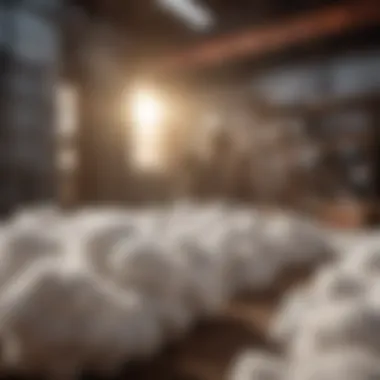Exploring the Impact of Cotton Recycling Companies


Intro
Cotton recycling sits at the intersection of environmental sustainability and textile production. The global cotton industry faces significant challenges regarding resource usage and environmental impact. The widespread growing of cotton requires a considerable amount of water, land, and energy. Moreover, the conventional processes for processing and disposing of cotton textiles contribute to pollution and waste in landfills.
Understanding the importance of cotton recycling is crucial. Not only does it help in reducing waste, but it also conserves resources and minimizes the carbon footprint associated with new cotton production. By advocating for and implementing recycling processes, the industry can shift towards a more circular economy. This approach not only benefits the environment but also enhances company reputations and caters to increasingly eco-conscious consumers.
Recently, the conversation around sustainable practices in textiles has developed momentum. It's evident that the intricacies of cotton recycling deserve thorough exploration. This examination reveals how these companies contribute to the broader goals of resource management and underscores their role in environmental conservation.
Throughout this article, we will delve into various aspects of cotton recycling companies, assessing current challenges, innovative solutions, and their overall impact on the industry and the planet.
The Necessity of Cotton Recycling
In recent years, the focus on sustainable practices has intensified across various industries, but none more so than in textiles. Cotton recycling plays a crucial role in addressing environmental concerns and resource management within this sector. The necessity of cotton recycling extends beyond mere waste reduction; it encapsulates a more profound commitment to preserving our planet’s health.
Understanding Cotton Waste
Cotton waste can be categorized into several types, including pre-consumer and post-consumer waste. Pre-consumer waste involves the scrap generated during the manufacturing process. This scrap often goes to landfills, contributing to significant amounts of waste in the textile sector. On the other hand, post-consumer waste refers to discarded clothing and textiles no longer used by consumers. The global cotton waste problem is exacerbated by increasing consumption rates, leading to textile waste almost reaching 92 million tons annually.
The understanding of these waste types is fundamental for cotton recycling initiatives. By gathering data on the origins and volumes of cotton waste, companies can devise effective recycling strategies. Moreover, comprehending the cycle of cotton waste empowers businesses to divert end-of-life garments from landfills.
Environmental Impacts of Textile Production
The environmental footprint of textile production, particularly cotton, is staggering. Conventional cotton farming relies heavily on pesticides, fertilizers, and significant water resources. The production process itself generates substantial carbon emissions. According to recent studies, textile production contributes up to 10% of global greenhouse gas emissions. The water used in cotton processing can cause severe stress on local ecosystems, further complicating ecological dynamics.
The impacts extend beyond just resource usage. Each step in the textile supply chain contributes to pollution and increases ecological degradation. This highlights the pressing need for practices that mitigate these environmental impacts. Recycling cotton can be a game-changer in this regard. It not only reduces the need for virgin material but also minimizes energy consumption, waste generation, and overall pollution.
Benefits of Recycling Cotton
Implementing cotton recycling provides multiple benefits that align with sustainability efforts. First, it conserves natural resources like water and energy, reducing the demand for raw cotton. This process can drastically minimize the environmental impact of cotton production.
Second, recycling cotton diverts waste from landfills, reducing the overall volume of textile waste that ends up polluting environments. It also promotes a circular economy, encouraging the reprocessing and re-manufacturing of materials, thus contributing to resource efficiency.
Additionally, there are economic incentives associated with cotton recycling. Businesses engaged in these practices can leverage the growing demand for sustainable products, enhancing their market position. They can also reduce costs linked to waste disposal and raw material procurement.
"Recycling cotton can significantly reduce overall resource use in textile manufacture, paving the way for a more sustainable future."
The Cotton Recycling Process
The process of recycling cotton is critical for promoting sustainability within the textile industry. As we delve into this section, it is imperative to acknowledge the various stages involved, which transform cotton waste into valuable resources. Each step has its unique significance, contributing to environmental conservation and resource efficiency.
Collection of Cotton Waste
The first stage in the cotton recycling process is the collection of cotton waste. This phase involves gathering discarded cotton garments, textile scraps, and production leftovers. Collection is vital because it initiates the recycling chain. Efficient collection can take place through various channels, including textile banks, found in many communities, and drive events dedicated to collecting old clothes. Retailers and brands also play an important role by participating in take-back programs, enhancing overall collection rates.
The effectiveness of this stage can directly influence the quality and quantity of recycled material that will be processed later. Thus, robust collection frameworks are essential for the success of the cotton recycling endeavor.
Sorting and Grading


Once collected, the cotton waste must be sorted and graded. This step determines the suitability of the materials for recycling. Sorted materials typically include pure cotton fabrics, blended fabrics, and non-recyclable items. The categorization depends on fiber content and condition.
Grading is equally important; high-quality fibers can be reused effectively, while lower quality may only serve for less demanding applications. Accurate sorting and grading ensure that recycled cotton is of a high standard, helping to minimize contamination and maintain quality in the final product.
Shredding and Processing
After sorting, the next phase is shredding and processing. Here, the cotton waste is mechanically shredded into smaller pieces. This action facilitates the removal of non-cotton materials, like buttons or zippers. The result is a fluffy, fibrous material ready for further processing.
The processing phase often includes cleaning and treating the fibers to ensure they meet the required specifications for reuse. During this stage, any impurities are eliminated, allowing for a pure cotton base for the next steps in recycling. The effectiveness of shredding and processing significantly affects the recyclability and quality of cotton fibers.
Re-spinning and Fabric Creation
The final stage of cotton recycling is re-spinning and fabric creation. The cleaned and processed fibers are spun into new yarn. This yarn can then be woven or knitted into fresh fabric, which can be used to make new clothing items or other textile products.
It is essential to note that recycled cotton may not have the same durability or performance as virgin cotton. However, innovations in technology and processing techniques are helping to improve the quality of recycled cotton. The advent of advanced spinning techniques also enables recycling companies to create new blends, pushing the boundaries of what recycled cotton can offer.
"Recycling cotton is not just about waste management. It is about creating a circular economy where resources are valued and utilized to their fullest potential."
In essence, each step of the cotton recycling process is designed to maximize the resources inherent in cotton waste. From collection through to fabric creation, the process encapsulates a sustainable approach that helps reduce environmental footprints in the textile industry.
Leading Cotton Recycling Companies
Cotton recycling companies play a crucial role in transforming textile waste into valuable resources. These companies contribute significantly to the circular economy, encouraging sustainability and reducing environmental impacts. Their operations not only help manage the substantial waste generated by cotton production but also promote innovative solutions that can inspire further advancements in the textile industry. Thus, understanding the leading companies in this sector helps in appreciating their impact on resource management and environmental conservation.
Company Profiles
Company A: Innovations in Cotton Recycling
Company A is renowned for its innovations in the field of cotton recycling. By utilizing advanced technology, this company focuses on breaking down used cotton textiles to create high-quality recycled fibers. One key characteristic of Company A is its commitment to improving the efficiency of the recycling process. This focus on innovation makes it a popular choice for brand collaborations. The unique feature of Company A lies in its proprietary technology that enhances fiber quality while reducing energy consumption. This advantage not only appeals to sustainability-minded consumers but also contributes to cost-efficiency in production.
Company B: Sustainable Practices and Impact
Company B stands out for its robust sustainable practices and measurable impact on reducing textile waste. They integrate ethical sourcing and community involvement in their recycling initiatives. The focus on sustainability makes Company B a sought-after partner in eco-conscious fashion. A distinctive aspect of Company B is its circular model that not only recycles fibers but also promotes eco-friendly raw materials in new garment production. This approach helps minimize overall environmental footprint, though sometimes it may require higher initial investments.
Company C: Scaling Operations Globally
Company C exemplifies the capacity to scale operations on a worldwide level, addressing cotton waste challenges irrespective of geographical barriers. Its ability to manage vast networks of sourcing and processing facilities is a key factor for its success. Company C’s global reach allows it to access a larger volume of post-consumer cotton waste. The unique feature here is their collaborative efforts with local organizations to streamline collections. The advantage of this model is its potential for substantial impact; however, it can face challenges in maintaining quality across numerous international facilities.
Market Position and Influence
The market position of these leading cotton recycling companies is pivotal in shaping industry standards and practices. They influence how textiles are perceived, shifting consumer perspectives toward sustainability. As these companies establish themselves as leaders, they create a ripple effect, encouraging smaller entities to adopt recycled practices and innovate. Their market power extends beyond recycling; they are positioned at the intersection of environmental responsibility and economic viability, often leading initiatives that respond to consumer demand for sustainable products.
"Cotton recycling is not just about waste management; it represents an essential shift towards responsible consumption and production in the textile sector."
The ongoing efforts of these companies to refine their methods Bhelp establish a sustainable economy within the textile industry, making their contributions invaluable to both environmental and social dimensions.
Technological Innovations in Cotton Recycling


Technological innovations play a crucial role in the cotton recycling industry. They enhance efficiency, sustainability, and the overall effectiveness of recycling processes. As technology advances, it aids in transforming used cotton into new products, thus reducing waste and environmental impact. Companies are increasingly relying on advanced machinery and methodologies to streamline their operations, creating a more circular economy within the textile sector.
Advancements in Recycling Technology
Recent years have seen significant advancements in cotton recycling technology. Notably, innovations in fiber separation and identification techniques have improved the quality of recycled cotton. For example, laser technology and optical sorting systems can help distinguish between different types of fibers, ensuring that only high-quality cotton is processed. This improves the end product and enhances the appeal of recycled materials to manufacturers.
Other innovations include advanced shredding machines which can efficiently break down cotton fabric without damaging the fibers. These machines are designed to preserve the inherent qualities of cotton, thus maintaining its value as a raw material. Furthermore, automation in the recycling process minimizes manual labor, reduces costs, and increases output. The integration of data analytics also enables companies to optimize their recycling operations by monitoring performance metrics and identifying areas for improvement.
Research and Development Initiatives
Research and development within the field of cotton recycling is essential for fostering innovation. Universities and research institutions are collaborating with industry leaders to explore new recycling methods and improve existing technologies. One focus is on developing biodegradable additives that can enhance the properties of recycled cotton, making it more competitive against virgin materials.
Moreover, funding initiatives are increasingly available for startups that aim to revolutionize the recycling industry. These businesses often introduce pioneering technologies or sustainable practices that challenge traditional methods. By prioritizing R&D, the cotton recycling sector can innovate continuously, adapt to market demands, and overcome existing challenges.
Legislative and Economic Context
The legislative and economic context surrounding cotton recycling is crucial. It shapes how companies operate within this space. Legislation can significantly influence the sustainability practices of cotton recycling companies. It provides a framework that encourages recycling initiatives, promoting environmental conservation. Given the pressing need for sustainable practices, these policies are more than just regulations; they are the backbone of industry growth. Without adequate legislative support, many recycling operations may struggle to justify their existence.
Policies Supporting Recycling Initiatives
In recent years, governments worldwide have been implementing policies to promote cotton recycling. These policies often aim to reduce waste and encourage the recycling of textile products. For instance, some countries provide incentives for companies that actively engage in recycling. These can come in various forms, such as tax breaks or subsidies. Furthermore, limited legislation exists that mandates recycling for certain materials, including cotton. This compulsion can help stimulate demand for recycled cotton products.
Another critical aspect of supporting policies is setting recycling targets. Many regions have adopted ambitious goals for waste reduction over the next few decades. These targets can affect the operations of cotton recycling companies, as they must adapt to meet these standards. Initiatives like extended producer responsibility can also play a role, compelling manufacturers to ensure the end-of-life management of their products.
Economic Viability of Recycling Businesses
The economic viability of cotton recycling companies is dictated by various factors. The market for recycled cotton products has grown, driven by consumer demand for sustainable fashion. However, the financial health of these companies also depends on raw material costs, competition with virgin materials, and production processes.
Recycled cotton often costs more to produce than new cotton. Therefore, to remain competitive, companies need to find ways to minimize their operational costs. This can involve investing in technology to streamline the recycling process. As companies innovate, they can improve efficiency and reduce costs, making them more sustainable economically.
Moreover, consumer awareness of the environmental impact of textile waste plays a significant role. If consumers prioritize sustainable products, companies producing recycled cotton are likely to see increased sales. Engaging consumers through education campaigns can help boost this awareness, ensuring that more people understand the benefits of choosing recycled cotton products.
Thus, the interplay between legislation and economic factors creates a dynamic environment for cotton recycling companies, necessitating adaptation and innovation.
Challenges Facing Cotton Recycling Companies
The cotton recycling industry faces several challenges that can hinder its potential growth and effectiveness. Understanding these obstacles is crucial to appreciate the broader context of cotton recycling and its role in sustainability. Addressing these issues can lead to improved practices and outcomes for both the environment and industry stakeholders.
Quality of Recycled Material
One of the foremost challenges is the quality of recycled material. The recycling process can sometimes yield products that do not meet industry standards or consumer expectations. The quality depends on various factors, including the initial condition of the cotton waste and the efficiency of the recycling methods employed.
The end-users of recycled cotton often have specific requirements regarding strength, softness, and dyeability. If recycled cotton does not meet these standards, manufacturers may hesitate to incorporate it into their new products. This reluctance can lead to a significant volume of cotton waste ending up in landfills rather than being transformed into new textiles.
To enhance the quality of recycled cotton, companies are investing in better sorting technologies and rigorous quality control processes. However, the variation in cotton waste types adds complexity to maintaining consistent quality across batches.
Market Competition


Market competition is another substantial challenge for cotton recycling companies. The textile industry is highly competitive, with numerous players aimed at fulfilling consumer demand. Many companies that produce new cotton or synthetic fabrics can often offer lower prices due to lower production costs. This can make it difficult for recycled cotton products to compete effectively in the market.
Additionally, as sustainability becomes increasingly important, more brands are entering the recycling space. This increase in competition puts pressure on existing companies to differentiate themselves through innovation and efficiency. Effective marketing strategies that emphasize the environmental benefits of recycled cotton can help bolster market positioning. However, this requires investment in both marketing and technology.
Consumer Awareness and Engagement
Consumer awareness and engagement are critical aspects that can influence the performance of cotton recycling companies. Many consumers still lack knowledge about the benefits of recycling cotton, including environmental and economic advantages. This gap can lead to low demand for recycled products, further complicating the growth of the recycling sector.
Educating consumers about the positive impact their purchasing decisions can make is vital. This can include information about how recycled cotton reduces landfill waste, conserves resources, and lowers carbon emissions. Outreach efforts may take different forms, from social media campaigns to workshops, yet many companies have not fully tapped into these avenues.
Engaging consumers also involves understanding their preferences and encouraging them to support recycled products. Collaborative initiatives between brands and communities can enhance awareness and foster a culture of sustainability. Without effective consumer engagement, the market for recycled cotton may struggle to expand, limiting its overall impact.
"Increasing consumer awareness of sustainable practices can lead to a significant shift in market dynamics, benefiting not only cotton recycling companies but also the environment as a whole."
Future Perspectives on Cotton Recycling
The future of cotton recycling holds a vital position in the textile industry, especially as environmental concerns grow. With increasing awareness around sustainability, more companies are integrating recycling practices into their operations. This integration is not only about mitigating waste; it's also about reinventing business models to become more efficient and responsible. The ongoing shift towards a circular economy underscores the need for innovations in this sector. These developments can potentially address both economic pressures and ecological issues.
Predicted Trends in the Industry
As the cotton recycling industry evolves, certain trends are emerging that stakeholders must pay attention to. Here are some notable predictions:
- Improved Technology: Advancements in recycling technology will continue to enhance the quality of recycled cotton. Methods like chemical recycling are being refined, allowing for the recovery of cotton fibers without significant loss of quality.
- Increased Collaboration: Companies are likely to collaborate more with others in the supply chain. This includes partnerships between manufacturers, retailers, and recycling firms to ensure better material flows and improved efficiencies.
- Consumer Demand: As consumers become more environmentally conscious, demand for recycled cotton products will rise. This shift is expected to push brands to prioritize how their materials are sourced and what happens at the end of a product's lifecycle.
- Integration of Circular Practices: Companies are expected to adopt circular economy models extensively, focusing on closed-loop systems. This approach seeks to minimize waste by ensuring that products can be reused or recycled at the end of their life cycle.
Integration with Sustainable Practices
Sustainability is no longer an option but a necessity in various industries, including textiles. Cotton recycling can align well with sustainable practices in several ways:
- Resource Conservation: Recycling cotton reduces the need for virgin materials, conserving water and reducing pesticide use associated with cotton farming. This is crucial, given the extensive resources that traditional cotton production demands.
- Waste Management: By integrating recycling, companies can effectively manage waste, diverting materials from landfills. This contributes to reducing overall environmental impact and supports local ecosystems.
- Eco-Friendly Products: Brands can market recycled cotton products as environmentally friendly alternatives. This not only enhances brand image but also caters to a growing consumer segment that prioritizes sustainability over other factors.
- Regulatory Compliance: As laws around waste and recycling become stricter, integrating recycling practices into business models can help companies remain compliant. This minimizes risk and prepares firms for future regulations.
"The integration of recycling into cotton production represents a critical step toward a sustainable future in textiles."
In summary, the future perspectives on cotton recycling indicate an evolving industry that can adapt to sustainability demands. The merging of technological innovations with green practices will likely define this space in the coming years, paving the way for a more sustainable textile industry.
Ending
The conclusion section of this article emphasizes the critical role of cotton recycling companies within the broader landscape of environmental sustainability. As the textile industry continues to face scrutiny over its environmental footprint, these companies emerge as vital agents of change. Recycling cotton helps mitigate waste, reduce pollution and foster a circular economy.
Summary of Key Insights
Throughout the article, several key insights emerge:
- Cotton Waste Management: Effective strategies in cotton waste management can help divert significant amounts of textile scrap from landfills.
- Environmental Benefits: Recycling cotton not only minimizes waste but also reduces the need for virgin materials, thereby conserving water and energy resources.
- Technological Advancements: Continuous innovation in recycling technology enhances the efficiency of recycling processes, presenting new opportunities for sustainability.
- Collaborative Efforts: Engagement of legislators, industries and consumers is vital to create a supportive framework for recycling initiatives.
These points underscore the multifaceted advantages of recycling in the cotton industry, highlighting its benefits not just for the environment but for the economy as well.
Call for Continued Innovation and Investment
As the demand for sustainable textiles grows, it is imperative that businesses and investors recognize the value of innovation in cotton recycling. The landscape is ever-evolving, and increased investment can spur advancements that will improve quality and scalability of recycled products. Key areas for investment include:
- Research Development: Further research into sustainable practices and improved recycling technologies can lead to more efficient operations.
- Consumer Education: Educating consumers about the importance of sustainability can drive more engagement and support for cotton recycling initiatives.
- Policy Support: Advocacy for policies that promote recycling can enhance the regulatory environment, creating more incentives for companies to participate in sustainable practices.
Collaboration among textile companies, governments and consumers is more crucial than ever in achieving a sustainable future for cotton recycling.



